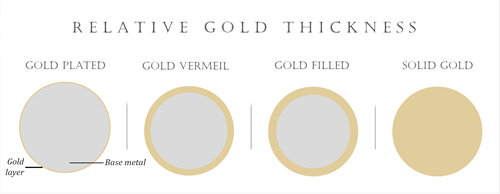
Navigating your way around the various terms used for gold jewellery can be confusing and intimidating, so I thought I’d attempt to throw some light on the differences between gold plated, gold vermeil, gold filled and solid gold jewellery.
Gold plated
* A very thin gold layer electrochemically plated to a cheaper base material (like copper or brass). Flash gold plating is under 1 micron thick (0.001 millimetres).
*Wears off very quickly and easily, allowing the base material beneath to tarnish.
*The base material can be coated in nickel, which can irritate skin.
*Other pieces can have a thicker coating, but there is no need for manufacturers to state thickness, so it’s very hard to know what you’re buying.
Gold Vermeil
* A much thicker gold layer electrochemically plated onto sterling silver.
* To be classified as Vermeil (pronounced Ver-May), the plating must be 2.5 microns thick (0.0025 millimetres), on sterling silver or fine silver, using 10k gold.
* Longer lasting (years), depending on how much use the piece gets, where it is worn (ring vs earrings), and how it is cared for.
* Will only tarnish if the gold wears away, exposing the sterling silver.
Gold Filled
* Not electroplated, but produced under much more labour-intensive processes.
* A sheet of gold (usually 14k) is bonded/melted through heat and pressure to a base metal (usually brass). Can be fused to either one side only, or both sides.
* To be classified as Gold Filled, the gold must be 1/20th of the entire weight of the piece (5%). Usually stamped with 1/20GF or 1/20 14K (depending on the karat of gold used).
* Very long lasting (decades), depending again on how much use the piece gets, where it is worn, and how it is cared for.
* Will only tarnish if the gold wears away, exposing the base metal.
Solid Gold
* Pure gold is 24 karats (out of 24).
* 24k gold is much too soft to make jewellery from, (as it would scratch, bend and break), so it is mixed with other metals to make it stronger (eg: zinc, copper, silver).
* The lower the percentage of gold, the stronger the alloy, but the lighter the appearance of gold colour.
* Alloys can range from 9k gold - 9 parts of gold out of 24 (37.5%), to 22k gold – 22 parts of gold out of 24 (91.7%).
* Solid gold is obviously the longest lasting option, but it also comes with a very hefty price tag!
I hope this has helped to clear up some questions you may have about the different types of gold jewellery available on the market, and how they stack up against each other.
If you would like more information on the processes I’ve outlined above, please get in touch!
Sign up to my monthly newsletter to be the first to find out about new collections,
pearl earring drops, sales, gift with purchase giveaways and more.
------------------------------------------------
Lilygriffin Jewellery: A Decade Of Creating
CUSTOMER SERVICE
-------------------
A little bit about types of gold jewellery
© Lilygriffin Jewellery 2025 Sterling silver and gold jewellery, handmade and painted in the brilliant colours of Aotearoa, NZ.